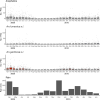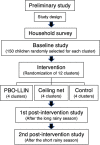A preliminary study on designing a cluster randomized control trial of two new mosquito nets to prevent malaria parasite infection
- PMID: 33372641
- PMCID: PMC7720478
- DOI: 10.1186/s41182-020-00276-x
A preliminary study on designing a cluster randomized control trial of two new mosquito nets to prevent malaria parasite infection
Abstract
Background: Although long-lasting insecticidal nets (LLINs) are the most effective tool for preventing malaria parasite transmission, the nets have some limitations. For example, the increase of LLIN use has induced the rapid expansion of mosquito insecticide resistance. More than two persons often share one net, which increases the infection risk. To overcome these problems, two new mosquito nets were developed, one incorporating piperonyl butoxide and another covering ceilings and open eaves. We designed a cluster randomized controlled trial (cRCT) to evaluate these nets based on the information provided in the present preliminary study.
Results: Nearly 75% of the anopheline population in the study area in western Kenya was Anopheles gambiae s. l., and the remaining was Anopheles funestus s. l. More female anophelines were recorded in the western part of the study area. The number of anophelines increased with rainfall. We planned to have 80% power to detect a 50% reduction in female anophelines between the control group and each intervention group. The between-cluster coefficient of variance was 0.192. As the number of clusters was limited to 4 due to the size of the study area, the estimated cluster size was 7 spray catches with an alpha of 0.05. Of 1619 children tested, 626 (48%) were Plasmodium falciparum positive using a rapid diagnostic test (RDT). The prevalence was higher in the northwestern part of the study area. The number of children who slept under bed nets was 929 (71%). The P. falciparum RDT-positive prevalence (RDTpfPR) of net users was 45%, and that of non-users was 55% (OR 0.73; 95% CI 0.56, 0.95). Using 45% RDTpfPR of net users, we expected each intervention to reduce prevalence by 50%. The intracluster correlation coefficient was 0.053. With 80% power and an alpha of 0.05, the estimated cluster size was 116 children. Based on the distribution of children, we modified the boundaries of the clusters and established 300-m buffer zones along the boundaries to minimize a spillover effect.
Conclusions: The cRCT study design is feasible. As the number of clusters is limited, we will apply a two-stage procedure with the baseline data to evaluate each intervention.
Keywords: Ceiling; LLIN; Malaria; PBO; RCT; Study design.
Conflict of interest statement
This study was partially funded by the manufacturer (Sumitomo Chemical Co. Ltd) of Olyset® Net and Olyset® Plus. However, the authors have no other financial competing interests and non-financial competing interests.
Figures






References
-
- ter Kuile FO, Terlouw DJ, Phillips-Howard PA, Hawley WA, Friedman JF, Kolczak MS, et al. Impact of permethrin-treated bed nets on malaria and all-cause morbidity in young children in an area of intense perennial malaria transmission in western Kenya: cross-sectional survey. Am J Trop Med Hyg. 2003;68(Suppl 4):108–114. - PubMed
-
- Flaxman AD, Fullman N, Otten MW, Menon M, Cibulskis RE, Ng M, et al. Rapid scaling up of insecticide-treated bed net overrage in Africa and its relationship with development assistance for health: A systematic synthesis of supply, distribution, and household survey data. PLoS Med. 2010;7:e1000328. doi: 10.1371/journal.pmed.1000328. - DOI - PMC - PubMed
LinkOut - more resources
Full Text Sources
Research Materials
